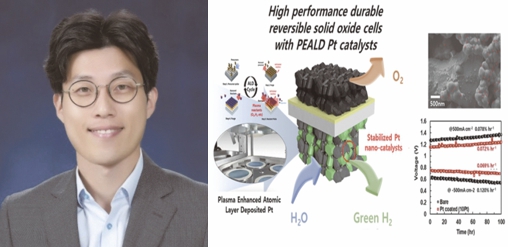
A research team led by Professor Jihwan An (ME), Dr. Hyongjune Kim (ME), Prof. Minhwan Lee from the Department of Mechanical Engineering at the University of California (UC Merced), and Prof. Haesun Park from the School of Integrative Engineering at Chung-Ang University has developed a high-efficiency, high-temperature stable fuel electrode catalyst for hydrogen production. The team utilized atomic layer deposition (ALD), an advanced semiconductor processing technique, to enhance efficiency while ensuring stability at elevated temperatures. The research was published in Applied Catalysis B: Environment and Energy.
Hydrogen is a clean energy source that produces no carbon dioxide emissions when burned, making it environmentally friendly. It also offers high energy efficiency during power conversion. Notably, green hydrogen is generated by electrolyzing steam using renewable energy, enabling its use in various industries, including electric vehicles, to produce power sustainably. Reversible Solid Oxide Cells (rSOC) are promising next-generation devices capable of hydrogen production and electricity generation, offering versatility for future energy solutions. However, nickel-yttria-stabilized zirconia (Ni-YSZ), the typical fuel electrode in rSOC, struggles to improve hydrogen production efficiency in humid environments. Metal catalysts face challenges due to high costs and rapid degradation.
The team used plasma-enhanced Atomic Layer Deposition (PEALD) to form uniform platinum nanoparticle coatings on 3D structures. They successfully applied a minimal amount (0.2μg/cm2) of platinum nanoparticles to the rSOC electrode surface.
As a result, the team significantly improved rSOC’s efficiency for hydrogen and power production efficiency with a minimal platinum coating. They maintained stable performance at 700°C for 100 hours. Unlike typical nanocatalysts, their electrode maintained durability due to a stabilization mechanism that sustained high-density interfaces on the Ni-YSZ surface.
Prof. An stated, “While semiconductor and hydrogen technology may seem entirely different, this study shows the potential of combining the two fields.” He noted that advanced atomic-level semiconductor processes, already benefiting from economies of scale, effectively address the efficiency-durability dilemma in energy devices.
This study was supported by the Ministry of Science and ICT, Korea Energy Technology Evaluation and Planning, and University-Centered Research Institute Program.


